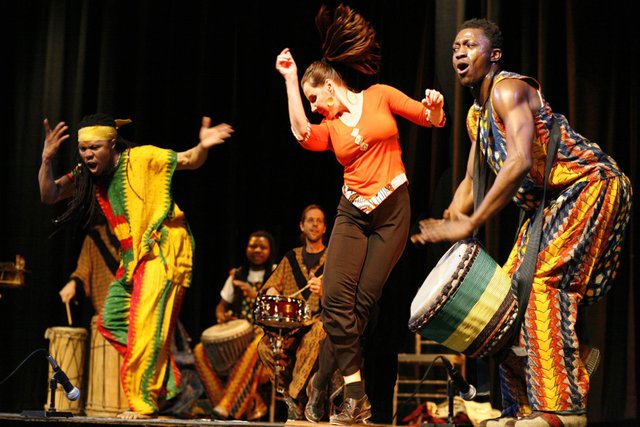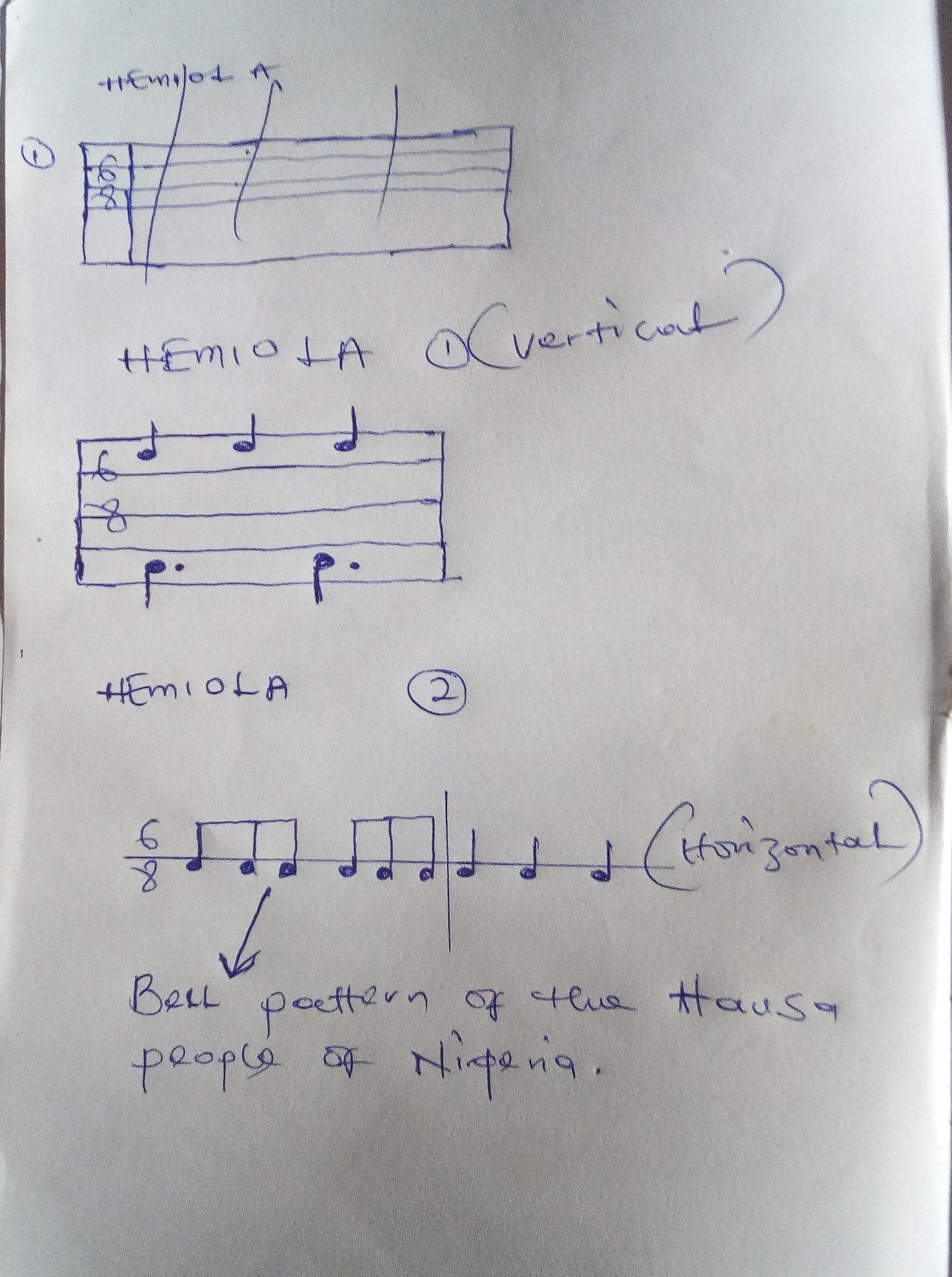Instrumental Techniques in African Music

African music is highly rhythmic.
It is believed that African music evolved as rhythmic before it graduated to melodic. So it will be inappropriate to try to analyze African music without referencing African rhythm. In comparison to the music of other parts of the world (note: the western world is the only part of the world whose music is not rhythmically complex¹), African music possesses very complex rhythmic structures, making it harder for proper notation. Because of this, Africans greatly rely on their oral traditions in passing over music from one generation to another. In contrast, in today’s Europe and America, it is very easy to lay hands on sheet music composed hundreds of years ago, thanks to the less complicated rhythm of music which permitted proper notation.
Africa’s dis-civilization played a part in hindering proper notation of early African music. That aside, African music is very complex to notate accurately, and even the most learned musicians would attest to this. In African music you will often hear very complex rhythms which involves playing different other rhythmic patterns against each other to create a concrete and rich polyrhythm.
Polyphony is the most dominant texture in both African vocal and instrumental music. In original African music you will hardly hear homophony and monophony, but rather polyphony; and in some cases (like ritual music played in the shrine), heterophony. It is in this sense that I'll discuss five major instrumental techniques in African music which are also very relevant techniques in their music as a whole, not only instrumental. Listening to both contemporary Afro genres and original African traditional music, you will agree with me that these techniques were, are still, and maybe will remain in use in African music.
TECHNIQUE ONE: HEMIOLA
We have both melodic and rhythmic hemiolas but we are going to stay within the context of this essay which is rhythm. When hemiola is being discussed in rhythm, the most common figure you would come across is 3:2. This figure summarizes and explains the whole concept of hemiola which is basically super imposition. Three beats of equal value are placed above two beats of equal value, this means that three beats of equal value are being played in the time of two, and vice versa.

Picture 1: This is an illustration of the vertical and horizontal hemiolas I drew for this article
The vertical hemiola is well felt when two instruments or voices (in vocal music) share the parts. One taking the lower and the other taking the upper. This division of parts would create a polyphonic texture. The horizontal hemiola is often played by single instruments or voices. The bell rhythm is often an hemiola. The diagram above is the bell pattern of the Hausa people of Nigeria.
TECHNIQUE TWO: HOCKET
Hocket technique is not only limited to instrumental music but also very much used in vocal music of other world cultures. Hocket is a medieval polyphonic technique which entails the alternating of single or multiple notes between parts. This means that a voice (or instrument) plays a single note or group of notes, as the case may be, and then rests as the other instruments sound a single or group of notes. It is more like a call and response between the voices.
Typically in an African ensemble, the master drummer plays a note or group of notes and another drummer responds while the master drummer rests and this may go on between two to five instruments or voices, creating a very beautiful and simple call and response pattern. To really explain this concept I’ll use a popular western tune to illustrate this. Let's use the first line from the tune When The Saints Go Marching In which is “oh when the saints / go marching in”. This line comprises of eight syllables which can be shared among different singers. Let's assume eight singers, each taking a syllable from the line. Singer 1 starts with the first syllable which is “oh”, singer 2 takes over with the next syllable which is “when" and it goes on like this till the last syllable is sung without interrupting the normal pulse of the music. This can also be achieved with two singers taking turns to sing a syllable or group of syllables. That is a hocket in vocal music. The same is applicable to African instrumental music.
To further explain this, I made two videos illustrating the single and multiple note hockets. Pay attention to the alternating notes between the TWO players, creating a call and response pattern. Thanks to my brother for lending a hand, literally :-)
Video 1: Multiple Notes Hockets
Video 2: Single Note Hockets
TECHNIQUE THREE: CROSS RHYTHM
Cross rhythm is a specific form of polyrhythm. Cross rhythm occurs when there is a movement or displacement of some beats in a time pattern to point behind or ahead of their normal positions. The 3:2 ratio cross rhythm is the most commonly used one in African music. The two lower notes are the most important or primary notes while the three displaced notes on top are the primary notes which act as the pulse of the music, while the accompanying instruments accents the secondary notes which complement the downbeats.
In African music the downbeat is not basically played by an instrument, the pulse is felt individually by each player, unlike in western or big band music or jazz band where every musician refers to just one source for the downbeat or the pulse. In typical western music every musician can just tab a foot to this downbeat, but this is not the case in African music. My own downbeat while I'm playing the drum may differ from my fellow musician’s downbeat who is also playing a drum.
TECHNIQUE FOUR: SYNCOPATION
Syncopation in music basically means an offbeat rhythm or unexpected rhythm. Syncopation is the interruption of a regular pulse or rhythmic flow.
Syncopation is very much vital in African dance music and it is also used to introduce new musical ideas or rhythmic patterns into a piece of music. It is used to change things up because of its ability to bring surprise and it is also used to transit into the call and response section or used to end a section of improvisation. Syncopation is felt when a rhythmic pattern that should typically fall on strong beats falls on weak beats instead.
TECHNIQUE FIVE: CALL AND RESPONSE
As the name suggests, this technique is very simple but also very much evident in African music. It has become a sort of signature in African music. In this technique, a leading percussionist or group of percussionists play a rhythmic pattern and the others respond. In order to really have a feel of instrumental call and response, you can check out Ekpo music of the Efik/Ibibio people of Nigeria.
CONCLUSION
The complexity of African music makes it beautiful and not hard to play. In a further post I will make a lot of videos highlighting the application of these patterns of rhythm in many African cultural practices, which include masquerades, plays and many more instances. In the meantime, I hope you found this informing and enlightening. Feel free to upvote and resteem.
Reference ¹
Cover Image credit
All other pictures are original.
It's amazing how you dig up these music concepts and relate them to their root "AFRICA".
And these are techniques a typical african kid would do with ease but wouldn't recognise it on sheet. We need more contents like this, not just on steem. Looking forward to seeing the applications of these techniques. Nice one.
its amazing how you can clearly hear the african(west especially)influence in brazilian music like:
and it slowly took form becoming more melodic and its own style.
also a crazy fact about west african tribes - they use and used fixed rhythm songs as lullaby because they found it too boring and calming!
its amazing how the added another dimension into the rhythm, its not that they dont have melody, the rhythm is their melody!
Wow! I am so proud of this piece. This is a honourable addition to the Steem blockchain. I wish for more creators like you. Kudos. I resteem this to help shoot it to the moon. I definitely will hook you up on a lot of projects I plan to embark on next year. We will work to create a haven of original African contents on the www. Kudos. Great work. Well researched. I wish you can offer links to future readings on the subject. And I look forward to the follow up contents you promise.
Thanks man. I am definitely ready for whatever projects
Really informative. Though I'm familiar with some these techniques, I didn't even know what they are called. Thanks bro. Greetings :)
You are welcome man
Wow really awesome
Am proud to hail from Africa👍🏻👍🏻
This is wonderful a gross analysis of African music. Hope you are part of this you will make a great African musician
Great post! I'm really getting into african music lately so this was a really informative read! I'll be sure to follow in hope for more posts like these. Cheers!
I will definitely blog more about African music
its really very helpful post for musicians ,thanks for sharing with us
This is amazing
Thanks for sharing @papaudeme
nice piece. very informative